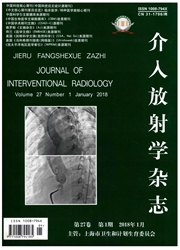

 中文摘要:
中文摘要:
目的本研究拟确定采用哪一种短期疗效评价标准能够客观、有效、准确地预测经TACE治疗的肝癌患者的预后。方法回顾性分析59例行TACE治疗的肝癌患者.收集治疗前及治疗后1个月的增强CT或增强MRI影像学资料。分别依据RECIST1.1标准和mRECIST标准行短期疗效评价,分析两种标准评价结果的一致性;然后依据不同的评价结果,将所有患者分为有效组和无效组,分别分析两组患者中位生存时间和2年生存率的差异。结果对所有患者进行短期疗效评价。依据RECIST1.1标准评价为CR、PR、SD、PD的患者;依据mRECIST标准评价为CR、PR、SD、PD的患者:两种标准内部一致性极差(K=0.19,95%CI,0.16~0.26)。依据RECIST1.1标准,有效组和无效组患者中位生存时间分别为25个月和20个月,2年生存率分别为62%和80%,两组差异无统计学意义(P〉0.05);依据mRECIST标准,有效组和无效组患者中位生存时间分别为25个月和14个月。2年生存率分别为84%和68%,两组差异有显著统计学意义(P〈0.001)。多因素分析,mRECIST标准评价结果是预后的独立预测因素(P=0.02)。结论采用mRECIST标准评价经TACE治疗的肝癌患者较RECIST标准更有优势。
 英文摘要:
英文摘要:
Objective To determine which criteria, RECIST 1.1 criteria or modified (mRECIST) criteria, is more objective, effective and accurate in predicting the prognosis of patients with hepatocellular carcinoma (HCC) after transcatheter arterial chemoembolization (TACE) treatment. Methods The clinical data of 59 HCC patients who had received TACE were retrospectively analyzed. The enhanced CT or enhanced MRI imaging materials, which were performed before and one month after TACE, were collected. According to the RECIST 1.1 standard and the modified RECIST (mRECIST) standard the short-term effectiveness was separately evaluated, and the consistencies of the two evaluation results were analyzed. Based on the different evaluation results, all patients were divided into effective group and ineffective group, and the differences in median survival time and 2-year survival rate between the two groups were compared. Results The short- term efficacy was evaluated in all patients. According to RECIST 1.1 criteria, the patients were classified into CR, PR, SD and PD subgroups; and also according to mRECIST criteria, the patients were classified into CR, PR, SD and PD subgroups. The internal consistency of the two standards was poor (Kappa=0.19, 95% CI:a16-0.26). According to RECIST 1.1 standard, the median survival time of the effective group and ineffective group was 25 months and 20 months respectively, and the 2-year survival rate was 62% and 80% respectively, the differences between the two groups were not statistically significant (P〉0.05). According to mRECIST standard, the median survival time of the effective group and ineffective group was 25 months and 14 months respectively, and the 2-year survival rate was 84% and 68% respectively, and the differences between the two groups was statistically significant (P〈0.001). Multivariate analysis showed that mRECIST standard evaluation results were independent predictors of prognosis (P=-0.02). Conclusion In evaluating the prognosis of HCC pa
 同期刊论文项目
同期刊论文项目
 同项目期刊论文
同项目期刊论文
 期刊信息
期刊信息
